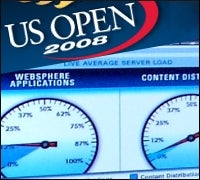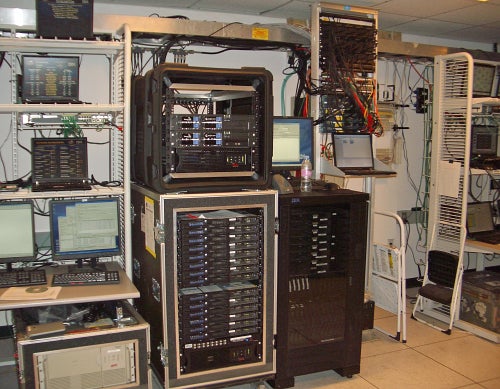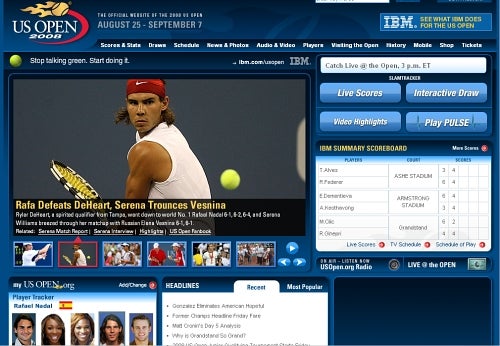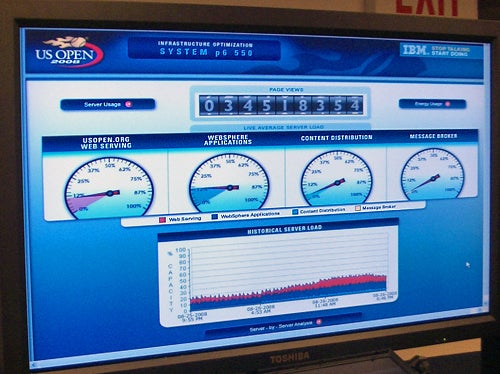 |
NEW YORK — This week marked the commencement of the U.S. Open, and those
here in the New York area not exhausted by Olympimania have two weeks of
top-notch tennis to look forward to.
Yes, we’re already seeing great things from perennial heroes like
four-time U.S. Open champion Roger Federer, and Rafael Nadal, fresh off ascending to No. 1 in the world and taking Olympic gold in Beijing for Men’s Singles.
And, naturally, we’ll be staying tuned to see whether Venus and Serena
Williams will face off in the quarter finals, as seems likely — and,
of course, which of the two sibling powerhouses (themselves also recently
minted gold-medal winners in the Olympics) will emerge victorious from the duel.
But as with every year, the event’s tireless organizer — the United
States Tennis Association (USTA) — is working behind the scenes (and below
Arthur Ashe Stadium here at the Billie Jean King National Tennis Center)
with another group of notables to make sure the above-ground action goes
according to plan. Once again, IBM is one of the key sponsors the USTA has tapped
for the effort.
And as it has for the past 17 years, Big Blue is flexing its technological
might to enable much of what makes the U.S. Open happen on and off the
court.
 Behind the scenes with IBM at the U.S. Open. Click to enlarge. |
Yes, you read that right: Big Blue has been a sponsor of the Open for 17
years. True, most sponsorships are chiefly about cash being handed over in
return a lot of signage and promotion — including giveaways like branded
handheld fans and Evian water spray bottles, both of which are musts for the
often-stifling days here in Flushing, Queens.
Still, there’s plenty of opportunity for the companies involved to do
more than simply ride the coattails of a major sporting event with copious
signage. IBM, in particular, takes both aspects of the job very seriously,
using the sponsorship not just as a promotional outlet but also as a message in its own right.
With 17 years under its belt, what’s new about IBM’s participation in the
tournament this year? In large part, what’s new is positioning — specifically, “green” positioning.
From Big Blue to Big Green
IBM has always used the event as a showcase of some of the
“best-of” technology in its arsenal — tying in its enabling technology with
the hot trends in business and communications at the time.
At the start of its work with the Open and the USTA, IBM provided the
technology underlying scoring, scoreboards and transmitting scoring data.
When the dot-com boom hit, IBM was there powering the Open’s Web presence.
As Linux and open systems took off, IBM was there providing those
technologies, as well. And in more recent years, IBM’s been driving a move
toward virtualized datacenters to aggregate, organize and distribute the
vast video, scoring and player data the Open produces daily.
Virtualization’s certainly still a key focus of what IBM’s doing here at
the Open. But thanks to IBM’s multibillion-dollar Big Green push toward
energy-efficient operations, products and services, the technology’s taking
on another role: leading the charge for the energy-efficient datacenter, and
by extension, the cost-efficient business.
Next page: Green products, green message
Page 2 of 3
You already know the rhetoric behind virtualization and server In 2006, running the Open’s Web site, USOpen.org, required 60 servers. That’s six servers — a figure that includes built-in redundancy, mind At the heart of all this are the half-dozen IBM p6 550 servers, spread The machines use virtualized Linux The savings from all this is immediate and sizable: Energy consumption |
Green business
But it’s not all about hyping IBM’s own solutions. The benefits and the
importance of going green in business also ties neatly into what’s become a
major thrust of the USTA’s strategy.
In addition to working to create green solutions during the U.S. Open
from other sponsors like Evian (which promoted recycling during the
tournament) and Lexus (which provided hybrid vehicles), the USTA said it
places a high priority on making its own business and technology operations
more energy-efficient — in an effort to show how doable going green really
is.
“We spent really three years digging into our operations,” Michelle
Wilson, the USTA’s chief marketing officer, told a group of reporters here on Tuesday.
“We sit down every year and think about what message to send to the
world,” she said, placing the association’s green push in the context of
earlier years’ awareness efforts — such as those highlighting the role of
women in the sport with the 2006 rededication of the association’s complex
here as the USTA Billie Jean King National Tennis Center, and celebrating
the breaking of the color barrier with last year’s salute to Althea Gibson’s
1957 U.S. National Championships win.
“Green is a very, very important thing to our organization and to our
board of directors,” Wilson said. “Everyone tries to jump on the bandwagon,
and it was important to do something that was really significant” — not
just “putting out recycling containers in the food court.”
Next page: Scoring, scheduling and all that data
Page 3 of 3
Other chores still need doing
 Aggregating and distributing stats and updates seconds after they happen on the courts. Click to enlarge. |
The Web site’s only one portion of IBM’s participation in the Open:
There’s all the heavy lifting around collecting, sorting through, storing
and distributing data from the matches happening above.
Raw scoring and performance data — aggregated from judges’ and scorers’
handheld devices, and from statisticians working there in the media room —
is distributed within seconds to the USTA’s domestic media partners for use
in their own TV feeds and Web sites, as well as to USOpen.org. Global TV
affiliates get data-laden graphics made by the staff, which are also pushed
out and updated throughout a match. IBM WebSphere Business Integration
Message Broker and DB2 are the solutions responsible for this end of the
effort.
At the end of every match, each player also gets an interactive DVD,
created using IBM’s technology. The DVD provides a wealth of stats around
the player’s performance — most notably, a shot-by-shot breakdown of their
match — enabling them to closely review their performance later using the
reams of data IBM collected. (The DVD is processed and available
immediately after a match, courtesy of a rack of IBM’s System x Series
servers.)
 Roger Federer seconds after defeating Maximo Gonzalez. By this time, the match’s final scores have been pushed out online and to media partners through IBM’s delivery system. Click to enlarge. |
Then, there’s digitizing the draws, the schedule of matches, times and
locations each day of the tournament — a deceptively complex process that
until last year had been done by hand using what Pierce O’Neil, the USTA’s
chief business officer, described as little more than a big board and
magnetized name plates.
IBM’s also involved in tracking and broadcasting the speed of those
serves — and with U.S. star Andy Roddick holding what’s thought to be the record serving speed of 155 miles per hour and already pushing that limit during this
year’s Open, that’s no mean technological feat.
Additionally, Big Blue is providing the technology underlying the site’s
Web widgets, containing real-time scores, schedules, news and stats, and
which are embeddable on fans’ MySpace, Friendster, iGoogle pages and
elsewhere. And, oh yes, it also handles a little something called network
security.
Billions spent and saved on “Green”
IBM’s clearly got its hands full even beyond promoting Big Green. But
with energy-conservation in the enterprise such a hot topic, it’s no wonder IBM’s environmental and server consolidation work is taking the limelight.
That’s also not surprising for a company that’s taken the green message
to heart even within its own walls — with a downright Rafael Nadal-like
level of intensity.
 Oh, right. During all this, tennis is being played. Here, Venus Williams squares off against Samantha Stosur in the first round. Click to enlarge. |
Aside from purely allocating $1 billion annually to Big Green, IBM is transitioning its workforce so that close to half telecommute full-time; has
cut expenditures on its own datacenters over the past ten years enough for
$1.5 billion savings annually; and takes back 40,000 pieces of technology a
week, 99 percent of which gets reused or recycled.
Of course, whether more U.S. companies will follow the lead of IBM and
the USTA and buy seriously into the green revolution remains unclear. But
with two very different companies betting heavily on it internally — and
reaping the benefits — that’s a message that’s sounding more and more like
a winner all the time.
Christopher Saunders is managing editor of InternetNews.com.




